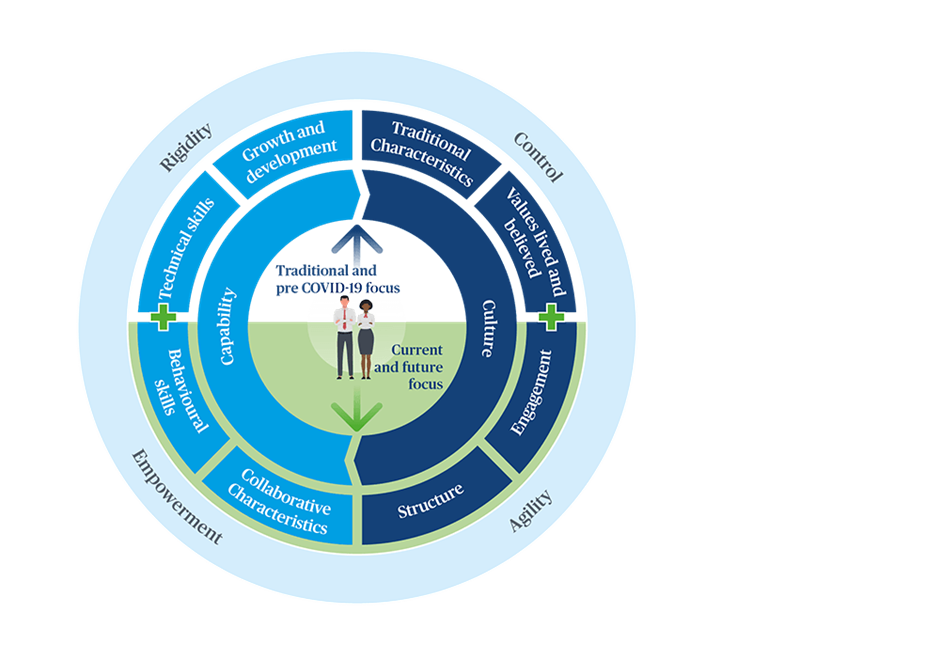Realising the extraordinary: enabling success through people
In the third of our ‘realising the extraordinary’ series, we summarise findings from industry leaders on how their businesses are evolving people strategies to future proof major projects and drive flexible, inclusive cultures.
Responding to the demands of an evolving market
The last decade has seen the construction industry come under increasing scrutiny for underperformance, project delays, cost overruns and inconsistent use of innovation. In response, business leaders have sought to build greater value in their organisations in several ways, notably through their teams and people. They understand how long term strategies, underpinned by the alignment of common programme outcomes, could be key to resolving long-standing capability and culture challenges on capital delivery programmes.
In the wake of the pandemic, some organisations’ capital projects require significant changes in approach to ensure they are viable for the changing environment. Leaders have had to adapt to fulfil their responsibilities to their people and engage their supply chain, for example, enabling COVID-safe working environments and providing greater job security. In addition, governments globally are investing in infrastructure to drive economic recovery, which is a positive move for the industry. In the short term, however, existing capability, skill and cultural challenges are being amplified and are challenging leadership teams as they try to keep pace.
Evolving a people strategy
As we adapt to these changing market conditions, we need to move quickly to recognise and resolve capability and cultural issues in parallel. Research carried out by our business over the past year identified the following themes:
| Theme | Our findings |
| There is a move away from rigid hierarchical structures: Organisations are embracing a move to more networked and fluid ways of working and reimagining their operating and organisational structures. Flatter and cross-functional structures are being favoured. | Leaner, flatter and more scalable. Airport operators globally are evaluating their operating model and organisational structures, looking at flatter and more integrated structures to provide flexibility. |
| Flexibility is now an expectation at all levels: Organisations that have a culture of embracing change are thriving, having been able to adapt quickly. Flexibility is also key to opening up to a broader pool of workers and closing capability gaps within the industry. | Three out of five was the average score given by organisations when asked to rate their ‘people’ approach in our 2020 survey of global industry leaders. This was the highest scoring category of all findings. |
| Leadership has been tested: In the wake of the global pandemic, leadership teams globally have had to prioritise safety above all else, including profit. Leaders have also been forced to adapt their working culture to be more flexible, basing it on a more virtual and remote working style. | One in three construction industry leaders surveyed in 2018 identified their culture as a key reason why major projects fail. The same proportion also identified a lack of collaboration from key project parties as contributing to project failure. |
| People and organisations are acknowledging the importance of outcomes: Uniting teams that are now virtually based has been challenging. Having a clear purpose is key to building a connection, attracting and retaining talent and supporting programmes to develop an engaged and motivated workforce. | Just over two in five (42 percent) of survey respondents believe organisations are working to improve people’s lives in their local areas. |
Addressing capability and culture needs
Our global industry engagement highlights how traditional approaches to people strategies are rapidly being overtaken by more agile, empowered and outcome-focused approaches. As an industry, we must recognise the changes in how our people work, develop and interact – and be alert to the trap of replicating past approaches that are comfortable and familiar, but ultimately won’t support industry change.
To address capability and culture needs at an organisational level, our findings demonstrate that leaders must embrace the opportunity to design or change major projects with new people strategies. They must create a culture that enables an aligned organisation and workforce, so that people work to achieve a common outcome which includes:
- Having a clear and simple project purpose, embracing innovation, and actively seeking sustainable solutions
- Creating fully ‘enabled’ organisations, with strong leadership and aligned accountabilities, that are supported through an empowered and capable workforce throughout the client and supply chain
- Greater focus on the set up and design of major projects to ensure its functions, people, and supply chain can operate effectively through considered strategies, building blocks, systems and processes.
Creating a fully enabled organisation
Through our research and work with clients around the world, we found the following factors to be key when building an enabled organisation, with a focus on capability and culture at its core.
These findings demonstrate how having the right capability means you can create the right culture; and how having the right culture means you attract the right capability. Finding the right balance means the organisation is an integrated, inclusive, empowered and controlled organisation, which gives people the ‘home’ and team unity they crave, with an energising and inspiring purpose. The diagram below sets out key elements to consider in creating an enabled organisation.

These four themes translate into priority areas of focus for building an enabled organsiation:
1. More integrated and inclusive teams and functions
Inclusive people approaches include an organisational structure that evolves over the project lifecycle. Through active leadership and functional alignment of common programme outcomes and targets, people can collaborate and problem solve together which drives innovation. The capability of organisations is also improved as people learn from each other and build on traditional technical skills with additional behavioural and collaborative characteristics.
2. A flexible culture that enables greater agility and speed
For an agile organisation there must be a flexible culture – which can transition between and evolve through the hierarchical, clan and adhocracy stages of an evolving organisation. Leadership teams are creating flexible cultures by nurturing an empowering environment and leading by example. They are also recognising behavioural skills and development opportunities that encourage a ‘growth mindset’ and agile thinking.
3. Leadership to create future breadth of capability
Empowering our leaders to identify, create and expand the capability needed for successful major projects is vital. To achieve this, leaders are more consciously planning for capability changes and are seeking to diversify their capability pool, by attracting skills or capabilities which may not traditionally have been valued. They are also creating capacity and recognising that to innovate and support teams, people need the headspace and environment to thrive.
4. A clear programme purpose to energise and unite the whole programme team
To develop a strong purpose that energises and unites a team, the reason ‘why’ tasks and work are done must be understood. Organisations are revisiting their values and vision and increasingly defining the purpose and outcomes every person contributes to. As more people work remotely, communicating these outcomes has become even more important. Critical also is the celebration of peoples’ contribution and there is now a greater emphasis not just on project or technical delivery but on recognising contributions to outcomes overall.
For further information contact:
To explore how other organisations are adapting their people strategies and understand the actionable steps that can be taken in the short term, request a copy of our full findings and solutions at [email protected].

